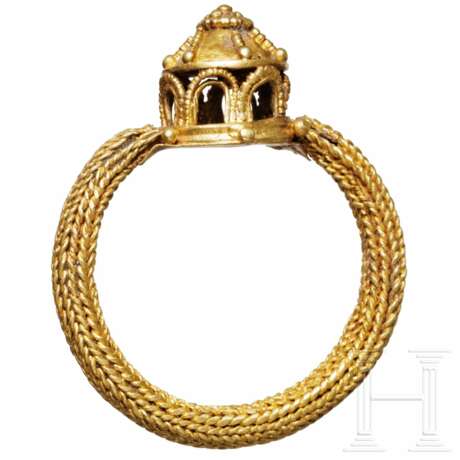Frühbyzantinischer Goldring mit Architekturmodell auf Ringplatte, 6. - 8. Jhdt. n. Chr.
19.11.2024 10:00UTC +01:00
Classic
Starting price
6000EUR € 6 000
| Auctioneer | Hermann Historica |
|---|---|
| Event location | Germany, Grasbrunn / München |
| Buyer Premium | 25 % |
Archive
The auction is completed. No bids can be placed anymore.

ID 1323334
Lot 4123 | Frühbyzantinischer Goldring mit Architekturmodell auf Ringplatte, 6. - 8. Jhdt. n. Chr.
Gleichmäßig breite, rundstabige Ringschiene von 3,5 mm Durchmesser, die aus zwölf Paaren miteinander verzwirnter Golddrähte zusammengesetzt ist, die der Länge nach verlötet sind. Innen hohl. Das feingliedrige Filigran der Ringschiene verleiht der Oberfläche eine lebhafte Struktur. Die Ringplatte besitzt einen Boden aus einem mandelförmigen Goldblech, auf dessen Spitzen die an den Enden leicht abgeplattete Ringschiene auf der Oberseite festgelötet ist. Im Zentrum der Ringplatte ein Architekturmodell eines Rundbaus mit sechs rundum verlaufenden Bögen und einem kegelförmigen Dach.
Unten eine "Brüstung" aus einem profilierten Blechstreifen, ringsum mit sechs Granalien in der mittig verlaufenden Hohlkehle verziert. Dahinter Bögen aus je zwei U-förmig übereinandergelegten Drähten, der innere glatt, der äußere ein Kerbdraht. Dieser die Binnenstruktur des Säulenwerks mit Bögen belebend. Getragen von diesen Säulen und Bögen das sechsfach facettierte, sich konisch nach oben verjüngende Dach, dessen Spitze von einem Kerbdraht eingefasst ist, über dem eine Pyramide aus Granalien lagert. Auf dem Dach sechs sternförmig nach unten verlaufende Kerbdrähte, vor der Traufe durch je eine Granalie abgeschlossen.
Minimale Inkrustationen und Bereibungen, sonst intakt. Ringgröße ca. 55, Innendurchmesser 18 mm. Höhe 3 cm. Breite 2,5 cm.
Ausgesprochen schönes und seltenes Exemplar eines frühbyzantinischen Prunkringes in ausgesprochen filigraner Ausführung. Vgl. ein ähnliches, jedoch weniger aufwendig gearbeitetes Exemplar im Louvre, Paris (Bj 1164).
Provenienz: Aus Münchner Privatbesitz, erworben Anfang des Jahrtausends im süddeutschen Kunsthandel.
An early Byzantine gold ring with architectural model on ring plate, 6th - 8th century A.D.
An early Byzantine gold ring with architectural model on ring plate, 6th - 8th century A.D.
Evenly wide, round-bar ring shank with a diameter of 3.5 mm, composed of twelve pairs of intertwined gold wires soldered lengthwise. Hollow on the inside. The delicate filigree of the ring shank lends the surface a lively structure. The ring plate has a base made from an almond-shaped sheet of gold, to the tips of which the ring band, slightly flattened at the ends, is soldered on the top. In the centre of the ring plate is an architectural model of a round building with six surrounding arches and a conical roof. At the bottom is a "parapet" made of a profiled strip of sheet metal, continuously decorated with six granules within the central groove. Behind this are arches made of two U-shaped wires laid one on top of the other, the inner one smooth, the outer one a notched wire, which enlivens the internal structure of the columns with arches. Supported by columns and arches, the six-facetted roof tapers conically upwards, the top of which is framed by a notched wire, above which is a pyramid of granules. On the roof, six notched wires running downwards in a star shape, each terminated by a granule in front of the eaves.
Minor incrustations and rubbing, otherwise intact. Ring size approx. 55, inner diameter 18 mm. Height 3 cm. Width 2.5 cm.
An exceptionally beautiful and rare example of a magnificent early Byzantine ring. Cf. a similar, less elaborately crafted example in the Louvre, Paris (Bj 1164).
Provenance: From private ownership in Munich, acquired at the beginning of the millennium from a southern German art dealer.
Condition: I -
| Auction house category: | Byzantium and the Middle Ages in Southeastern Europe |
|---|
| Auction house category: | Byzantium and the Middle Ages in Southeastern Europe |
|---|
| Address of auction |
Hermann Historica Bretonischer Ring 3 85630 Grasbrunn / München Germany | ||||||||||||||
|---|---|---|---|---|---|---|---|---|---|---|---|---|---|---|---|
| Preview | |||||||||||||||
| Phone | +49 (0)89 5472 649 0 | ||||||||||||||
| Fax | +49 (0)89 5472 64999 | ||||||||||||||
| Buyer Premium | 25 % | ||||||||||||||
| Conditions of purchase | Conditions of purchase | ||||||||||||||
| Business hours | Business hours
|


